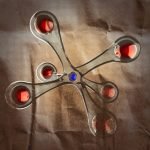CBD Use in the United States: A Cross-Sectional Study & Perspective
Docere
Jamie Corroon, ND, MPH
Cannabidiol (CBD) is one of more than 100 cannabinoids found in Cannabis sativa L (Cannabis spp, or Cannabis), a plant more well known colloquially as marijuana or hemp.1 With retail sales of hemp-derived CBD products reaching $170 million in the United States in 2016, and a projected compounded annual growth rate of 55% over the next 5 years,2 CBD is well on its way to becoming the darling of the natural products industry (Note: These estimates do not include marijuana-derived CBD).3 This emergence is especially intriguing given that CBD is currently renounced as a dietary supplement ingredient by the US Food and Drug Administration (FDA) and deemed a Schedule I Controlled Substance by the Drug Enforcement Administration (DEA).4,5 The regulatory status of CBD is expected to change soon, now that the FDA has approved Epidiolex (cannabidiol), the first Cannabis-derived pharmaceutical drug in the United States. Availability of Epidiolex is pending DEA rescheduling of cannabidiol, which is expected to occur before September 23, 2018.
Preclinical, and some clinical, studies demonstrate that CBD has broad therapeutic value, including reductions in seizures, psychotic symptoms, anxiety, depression, inflammation, neurodegeneration, symptoms of multiple sclerosis, and chronic pain, either used alone or when co-administered with tetrahydrocannabinol (THC).6-18 Despite this, little is known about why, and how, individuals are using CBD.
CBD Benefits & Questions
My co-author and I designed a study that sought to answer these questions. The study was just published in July 2018.19 It is the largest cross-sectional study of CBD use to be published in a peer-reviewed journal (n=2409).
According to our survey, CBD users are roughly balanced across gender (52% female), and tend to be older (43.4% older than 55 years of age) and college educated (71% earned a college degree or higher). Sixty-two percent use CBD to treat a specific medical condition(s). This is particularly interesting given that during recruitment for the survey, CBD had not been approved by the FDA to treat any medical condition. As of today, it is approved to treat 2 intractable seizure disorders in pediatric patients, but it is not yet commercially available.
Individuals are most often using CBD for chronic pain, arthritis/joint pain, and anxiety, but depression and sleep disorders are also common uses. The overall list of conditions is diverse and includes neurological, psychiatric, and autoimmune conditions. The perceived efficacy of CBD for these medical conditions is high. According to almost 36% of medical users, CBD works “Very well by itself.” Only 4.3% report that it does not work very well.
The majority of users learn about CBD from the internet or from family or friends (40% and 35%, respectively). Only 10% of all users, and 11% of those using CBD to treat a medical condition, learn about CBD from “a physician or naturopathic doctor.” This mirrors a trend in the broader medical Cannabis market, where individuals often receive “medical advice” from non-validated sources, including unlicensed individuals who may be sales representatives of Cannabis product manufacturers or dispensaries.20 It also highlights a potential concern, as CBD has been shown to interact with various prescription medications.21,22 More broadly, this may reflect a growing trend among consumers to take charge of their own healthcare and seek alternatives to conventional medicines.23
Almost half (48% for both) use CBD on a daily basis, and have been taking it for less than a year. Most use an oral method of administration (sublingual: 22%; capsules/pills: 14%; liquids: 12%; edibles: 11%). Roughly half (49%) use more than 1 method of administration. Topical application was the least-used method (11%).
Fifty-five percent of those studied reported regular marijuana use. This is significantly higher than the 2015 estimate of 8.3% (approximately 22.2 million) American adults.24 Regular marijuana users are more than twice as likely to report that CBD works “Very well by itself” than non-regular users. This difference may mean that marijuana provides additional symptom relief, above and beyond what is offered by CBD. It may also mean that marijuana users are confused about which therapy is responsible for the improvement in their symptoms, or that they are biased towards perceived efficacy of CBD, or both.
In an effort to distinguish it from “psychoactive” THC, CBD is often described as “non-psychoactive.” This is a misnomer. The reported efficacious use of CBD in this study to treat anxiety, depression, and posttraumatic stress disorder (PTSD), for example, suggests otherwise. This is corroborated by a variety of preclinical and clinical studies.10-12,25 Other preclinical studies describe interactions between CBD and a wide variety of receptors known to induce psychoactive effects, including a serotonin receptor (5-HT1A) and a GABA receptor (GABAA).13,26 It is more accurate to describe CBD as “non-intoxicating.”
Adverse Effects
Despite its favorable safety profile,27 adverse effects of CBD are reported.6,7,28 Fortunately, they are typically mild and dose-dependent. According to this study, 1 out of every 3 CBD users may experience an adverse effect, with the 5 most common being: dry mouth, dysphoria, hunger, red eyes, and sedation/fatigue. The frequency of adverse effects in this study is higher than in controlled studies, which often use high doses of isolated CBD6,7 rather than CBD in a whole-plant extract. Other studies have found no adverse effects.25,29
Interestingly, many of the adverse effects reported in this study are commonly associated with THC use.30 It is possible that both the adverse and therapeutic effects of CBD may, at least in some cases, actually be due to the presence of THC, or other compounds in the product. The chemical composition of a typical over-the-counter CBD product is highly variable. Independent research has confirmed that the CBD content in almost 70% of CBD-labeled products available online may be mislabeled. In one study, 43% of products were under-labeled and 26% were over-labeled for actual CBD content. More than 20% of CBD-labeled products contained detectable levels of THC.31
Conclusion
The use of CBD among individuals for specific medical conditions, as well as general health and well-being, is widespread. CBD is being used as a specific therapy for a number of diverse medical conditions – particularly pain and inflammatory disorders, but also anxiety, depression, and sleep disorders – often without the guidance of a trained healthcare provider. Most people find that CBD treats their condition(s) effectively in the absence of conventional medicine and without serious adverse effects; however, more clinical research is needed.
References:
- Upton R, Craker L, ElSohly M, et al, eds. Cannabis Inflorescence: Cannabis [Monograph] American Herbal Pharmacopoeia; 2014. Preview available at: https://american-safe-access.s3.amazonaws.com/documents/AHP_Cannabis_Monograph_Preview.pdf. Accessed May 5, 2018.
- Borchardt D. Hemp Cannabis Product Sales Projected To Hit $1 Billion In 3 Years. August 23, 2017. Forbes Web site. https://www.forbes.com/sites/debraborchardt/2017/08/23/hemp-cannabis-product-sales-projected-to-hit-a-billion-dollars-in-3-years/#5baca389474c. Accessed May 5, 2018.
- Wallace A. CBD debuts at Natural Products Expo West, heralded as “next big thing.” March 9, 2018. The Cannabist Web site. https://www.thecannabist.co/2018/03/09/cbd-hemp-natural-products-expo-west/100873/. Accessed May 6, 2018.
- US Food and Drug Administration. FDA and Marijuana: Questions and Answers. Last updated August 15, 2017. FDA Web site. https://www.fda.gov/NewsEvents/PublicHealthFocus/ucm421168.htm. Accessed May 6, 2018.
- Hudak J, Stenglein C. DEA guidance is clear: Cannabidiol is illegal and always has been. February 6, 2017. Brookings Web site. https://www.brookings.edu/blog/fixgov/2017/02/06/cannabidiol-illegal-and-always-has-been/. Accessed May 6, 2018.
- Devinsky O, Cross JH, Laux L, et al. Trial of Cannabidiol for Drug-Resistant Seizures in the Dravet Syndrome. N Engl J Med. 2017;376(21):2011-2020.
- Devinsky O, Marsh E, Friedman D, et al. Cannabidiol in patients with treatment-resistant epilepsy: an open-label interventional trial. Lancet Neurol. 2016;15(3):270-278.
- Leweke FM, Piomelli D, Pahlisch F, et al. Cannabidiol enhances anandamide signaling and alleviates psychotic symptoms of schizophrenia. Transl Psychiatry. 2012;2:e94.
- McGuire P, Robson P, Cubala WJ, et al. Cannabidiol (CBD) as an Adjunctive Therapy in Schizophrenia: A Multicenter Randomized Controlled Trial. Am J Psychiatry. 2018;175(3):225-231.
- Zuardi AW, Hallak JE, Dursun SM, et al. Cannabidiol monotherapy for treatment-resistant schizophrenia. J Psychopharmacol. 2006;20(5):683-686.
- Bergamaschi MM, Queiroz RH, Chagas MH, et al. Cannabidiol reduces the anxiety induced by simulated public speaking in treatment-naive social phobia patients. Neuropsychopharmacology. 2011;36(6):1219-1226.
- Crippa JA, Derenusson GN, Ferrari TB, et al. Neural basis of anxiolytic effects of cannabidiol (CBD) in generalized social anxiety disorder: a preliminary report. J Psychopharmacol. 2011;25(1):121-130.
- de Mello Schier AR, de Oliveira Ribeiro NP, Coutinho DS, et al. Antidepressant-like and anxiolytic-like effects of cannabidiol: a chemical compound of Cannabis sativa. CNS Neurol Disord Drug Targets. 2014;13(6):953-960.
- Hayakawa K, Mishima K, Fujiwara M. Therapeutic Potential of Non-Psychotropic Cannabidiol in Ischemic Stroke. Pharmaceuticals (Basel). 2010;3(7):2197-2212.
- Keating GM. Delta-9-Tetrahydrocannabinol/Cannabidiol Oromucosal Spray (Sativex®): A Review in Multiple Sclerosis-Related Spasticity. 2017;77(5):563-574.
- da Rovare VP, Magalhães GPA, Jardini GDA, et al. Cannabinoids for spasticity due to multiple sclerosis or paraplegia: A systematic review and meta-analysis of randomized clinical trials. Complement Ther Med. 2017;34:170-185.
- Johnson JR, Burnell-Nugent M, Lossignol D, et al. Multicenter, double-blind, randomized, placebo-controlled, parallel-group study of the efficacy, safety, and tolerability of THC:CBD extract and THC extract in patients with intractable cancer-related pain. J Pain Symptom Manage. 2010;39(2):167-179.
- Whiting PF, Wolff RF, Deshpande S, et al. Cannabinoids for Medical Use: A Systematic Review and Meta-analysis. 2015;313(24):2456-2473.
- Corroon J, Phillips JA. A Cross-Sectional Study of Cannabidiol Users. Cannabis Cannabinoid Res. 2018;3(1):1-10. Available at: https://www.liebertpub.com/doi/10.1089/can.2018.0006. Accessed July 10, 2018.
- Haug NA, Kieschnick D, Sottile JE, et al. Training and Practices of Cannabis Dispensary Staff. Cannabis Cannabinoid Res. 2016;1(1):244-251.
- Stout SM, Cimino NM. Exogenous cannabinoids as substrates, inhibitors, and inducers of human drug metabolizing enzymes: a systematic review. Drug Metab Rev. 2014;46(1):86-95.
- Jiang R, Yamaori S, Takeda S, et al. Identification of cytochrome P450 enzymes responsible for metabolism of cannabidiol by human liver microsomes. Life Sci. 2011;89(5-6):165-170.
- Greger JL. Dietary supplement use: consumer characteristics and interests. J Nutr. 2018;131(4):1339S-1343S.
- Substance Abuse and Mental Health Services Administration. Reports and Detailed Tables From the 2015 National Survey on Drug Use and Health (NSDUH). Last updated May 17, 2018. SAMHSA Web site. https://www.samhsa.gov/samhsa-data-outcomes-quality/major-data-collections/reports-detailed-tables-2015-NSDUH. Accessed May 6, 2018.
- Zuardi AW, Crippa JA, Hallak JE, et al. A critical review of the antipsychotic effects of cannabidiol: 30 years of a translational investigation. Curr Pharm Des. 2012;18(32):5131-5140.
- Bakas T, van Nieuwenhuijzen PS, Devenish SO, et al. The direct actions of cannabidiol and 2-arachidonoyl glycerol at GABAA receptors. Pharmacol Res. 2017;119:358-370.
- Iffland K, Grotenhermen F. An Update on Safety and Side Effects of Cannabidiol: A Review of Clinical Data and Relevant Animal Studies. Cannabis Cannabinoid Res. 2017;2(1):139-154.
- Devinsky O, Cilio MR, Cross H, et al. Cannabidiol: pharmacology and potential therapeutic role in epilepsy and other neuropsychiatric disorders. 2014;55(6):791-802.
- Jadoon KA, Tan GD, O’Sullivan SE. A single dose of cannabidiol reduces blood pressure in healthy volunteers in a randomized crossover study. JCI Insight. 2017;2(12). pii: 93760. doi: 10.1172/jci.insight.93760. [Epub ahead of print]
- Wang T, Collet JP, Shapiro S, Ware MA. Adverse effects of medical cannabinoids: a systematic review. 2008;178(13):1669-1678.
- Bonn-Miller MO, Loflin MJE, Thomas BF, et al. Labeling Accuracy of Cannabidiol Extracts Sold Online. JAMA. 2017;318(17):1708-1709.
Image Copyright: <a href=’https://www.123rf.com/profile_olegmalyshev’>olegmalyshev / 123RF Stock Photo</a>
 Jamie Corroon, ND, MPH, is the founder and Medical Director of the Center for Medical Cannabis Education. Dr Corroon is a licensed naturopathic doctor, peer-reviewed clinical researcher, and industry consultant with a focus on medical Cannabis. He is also a post-doctoral research fellow at the National University of Natural Medicine. Dr Corroon earned his ND degree from Bastyr University in Seattle, WA. He subsequently completed 2 years of residency at the Bastyr Center for Natural Health, and is a former adjunct professor at Bastyr University California. Dr Corroon earned a Masters in Public Health in Epidemiology from San Diego State University.
Jamie Corroon, ND, MPH, is the founder and Medical Director of the Center for Medical Cannabis Education. Dr Corroon is a licensed naturopathic doctor, peer-reviewed clinical researcher, and industry consultant with a focus on medical Cannabis. He is also a post-doctoral research fellow at the National University of Natural Medicine. Dr Corroon earned his ND degree from Bastyr University in Seattle, WA. He subsequently completed 2 years of residency at the Bastyr Center for Natural Health, and is a former adjunct professor at Bastyr University California. Dr Corroon earned a Masters in Public Health in Epidemiology from San Diego State University.










